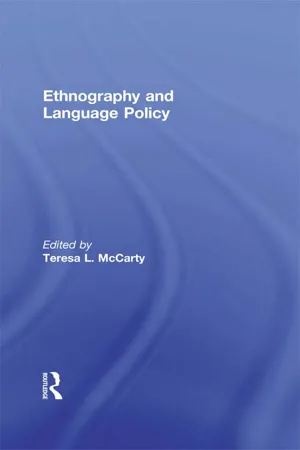History
Hopi Tribe
The Hopi Tribe is a Native American tribe located in northeastern Arizona. They are known for their rich cultural heritage, particularly their intricate artwork, traditional dances, and unique agricultural practices. The Hopi are also recognized for their strong spiritual beliefs, which are deeply rooted in their connection to the land and their reverence for nature.
Written by Perlego with AI-assistance
Related key terms
1 Key excerpts on "Hopi Tribe"
- eBook - ePub
- Teresa L. McCarty(Author)
- 2014(Publication Date)
- Routledge(Publisher)
Supawlavi, and tell ’em my clan, then, just what Hopi is about.By using the Hopi language, Dorian conveys a distinctly Hopi cultural identity. She used her title as a public platform to promote the importance of maintaining one’s heritage language: “If you know it, speak it; use it,” she implored. She further alluded to a deeper sense of the importance of the Hopi language to express a distinctly Hopi identity: “You don’t learn it for nothing … They [parents] didn’t teach us how to introduce ourselves in Hopi for nothing.”ConclusionContemporary Hopi youth such as Dorian, Jared, and Justin convey a mature understanding that every Hopi individual is vested with a personal responsibility and obligation to maintain the substance of Hopi culture by adhering to the traditions in a personal way and from a personal sense of duty (Spicer, 1975). Although their abilities in the Hopi language differ, the language nonetheless has a home in the context of these youths’ cultural worlds – in the course of daily activities, social institutions such as naming practices and marriages, and ritual performances and ceremonies. The youths’ experiences foreground the fact that there are messages in cultural practices beyond the words associated with the culture (Dauenhauer & Dauenhauer, 1998; Hale, 1998; Jocks, 1998; King, 2001; Urban, in King, 2001). Hopi traditions continue to be practiced so that for many Hopi youth who grow up in their villages, the Hopi world is the first world they come to know in the course of living it through active participation and involvement in those traditions. This suggests that while time and contact with the outside world have brought many changes, there continue to be Hopi who remain committed to corn as a way of life; one that continues to give purpose to and guides the Hopi people toward their destiny as established at Emergence. The continuing maintenance of Hopi traditions, then, offers a strong prospect for effective and successful language planning and language policy development directed toward “maximizing the influence of a particular language” (King, 2001, p. 12).
Learn about this page
Index pages curate the most relevant extracts from our library of academic textbooks. They’ve been created using an in-house natural language model (NLM), each adding context and meaning to key research topics.
